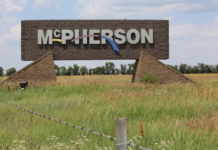USDA launches new regional program, aiding KDWPT in two projects
PRATT – Out of more than 600 pre-proposals and 200 full proposals submitted, two Kansas initiatives have been awarded state-level grant funding as part of the U.S. Department of Agriculture’s new Regional Conservation Partnership Program (RCPP). The regional program, which focuses heavily on public-private partnerships, aims to provide private companies, local communities, and other non-government partners a way to invest in efforts relating to land, water, agriculture, construction, tourism, and outdoor recreation. Both the Kansas Pheasant Initiative and the Regional Grassland Bird and Grazing Land Enhancement Initiative, a multi-state effort that also includes Missouri, Iowa and Nebraska, will receive funding from RCPP.
PHEASANT INITIATIVE
The Kansas Department of Wildlife, Parks, and Tourism (KDWPT), alongside the Natural Resource Conservation Service (NRCS), Pheasants Forever, Star Seed Inc., National Wild Turkey Federation, Quail and Upland Wildlife Federation, The Kansas Wildlife Federation, and Safari Club International, have developed a program geared at managing habitat for pheasants. This initiative uses a focus-area approach, providing cost-share and incentives for practices that create and maintain pheasant habitat. Because widespread, isolated efforts have proved less effective, the Pheasant Initiative will direct resources into focus areas to promote connectivity of projects and facilitate landscape-level population increases.
The initiative will use several traditional management practices to meet this goal, including the Conservation Reserve Program, but will also incorporate agricultural practices that have the potential to provide habitat.
“It seems that there is a widespread misconception that modern production agriculture and wildlife management are not compatible,” KDWPT small game specialist, Jeff Prendergast said.
“The funds from the RCPP program will give us the opportunity to promote modern production practices that are beneficial to wildlife, while being economically favorable to producers.”
The two focus areas include portions of Norton County and Mitchell/Osborne counties and both feature public wildlife areas. The RCPP funds will be utilized to implement cover crops and related practices to increase the availability of nesting and brood rearing cover while partners’ funds will be used to incentivize enrollment in other practices with the same goal.
REGIONAL GRASSLAND BIRD AND GRAZING LAND ENHANCEMENT INITIATIVE
The Regional Grassland Bird and Grazing Land Enhancement Initiative is a five-year project that will aid ranchers in enhancing and protecting the Flint Hills and Smoky Hill native prairies. Opportunities will be offered through key USDA conservation programs, including the Environmental Quality Incentives Program, the Conservation Stewardship Program and the Agricultural Conservation Easement Program (ACEP). Eligible landowners will be able to utilize practices such as prescribed burning, brush management and prescribed grazing to meet their management objectives. Through ACEP, producers can enter into easements that protect the agricultural use and conservation values of their eligible land.
KDWPT partners involved in the project include the NRCS, The Nature Conservancy of Kansas, Ranchland Trust of Kansas, and the Kansas Grazing Lands Coalition. KDWPT’s primary role will be providing technical assistance to landowners interested in participating in the program.
“The goals of this project are to implement management strategies that promote biodiversity and enhance grassland ecosystem functions, as well as address smoke management issues,” said KDWPT Farm Bill coordinator, Matt Smith. “By focusing additional resources on our native grasslands, it creates a win-win situation for our wildlife and the land stewards who manage these critical landscapes.”
For more information on these Kansas RCPP projects, and others, visit www.ks.nrcs.usda.gov.
Source: Kansas Department of Wildlife, Parks, and Tourism




